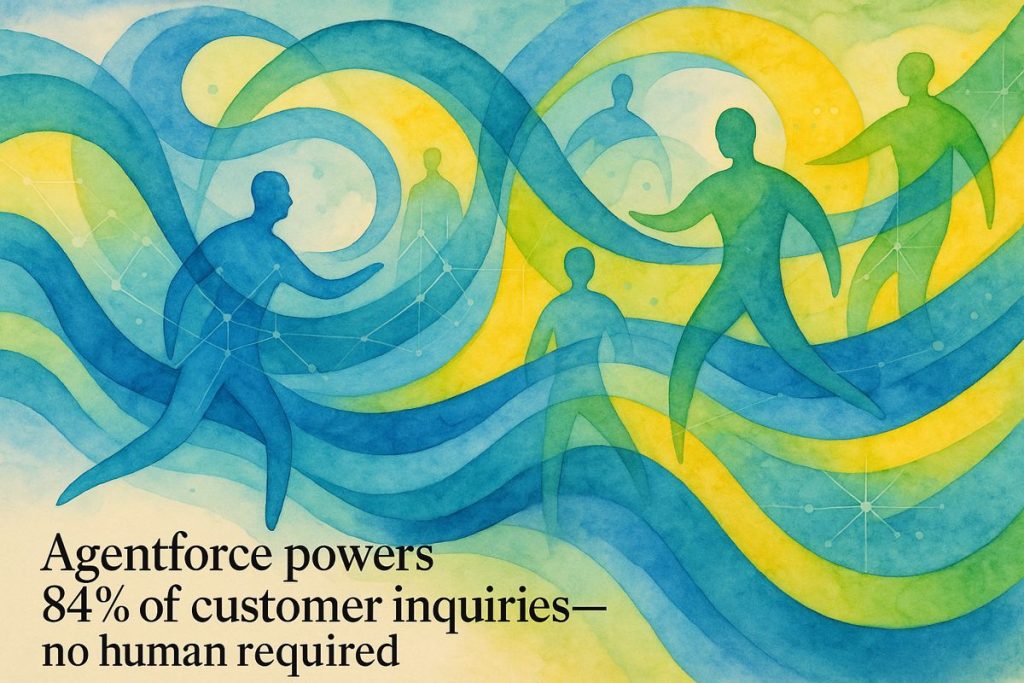Agentforce answers most customer questions without any humans, making work much faster, but some tech folks wish it was easier to use. Salesforce Agentforce is a smart AI tool that started in late 2024 and now solves most customer problems automatically. In 2025, it helped Salesforce make a lot more money, with $900 million coming from AI alone. Big companies like Equinox and OpenTable use Agentforce to speed up work, and almost half of Fortune 100 companies rely on Salesforce’s AI and Data Cloud. Overall, Agentforce is changing how businesses help customers, making things quicker and smarter.
What is Salesforce Agentforce and how is it impacting enterprise AI in 2025?
Salesforce Agentforce is an AI-powered automation platform launched in late 2024, designed to handle customer inquiries, streamline operations, and integrate with Salesforce’s Data Cloud. By 2025, it resolved 84% of customer issues without human intervention and contributed substantially to Salesforce’s $900 million AI revenue growth.
A New Agentic Epoch (Or, How I Stopped Worrying and Learned to Love the Bot)
Once upon a recent Tuesday, I found myself staring down a triple espresso and a Salesforce dashboard. Numbers everywhere—some climbing like ivy, some stubborn as lichen. Salesforce, that old palimpsest of CRM, is trying something ambitious (again): Agentforce, their AI-powered, agentic automation platform. It’s a move that smells faintly of ozone and big data, and one’s tempted to ask: is this the moment when enterprise software finally becomes self-operating, or just another round of digital optimism?
Since Agentforce’s late 2024 rollout, the ripples have been—well, let’s say perceptible. By early 2025, Salesforce boasted about 5,000 Agentforce deals, with 3,000 paid enterprise customers. That’s not hand-waving; it’s more like a brisk slap of reality. Twenty-five deals over $1 million, and three that crossed the $10 million Rubicon. Not bad for a platform that, in its earliest demos, reminded me of HAL 9000 moonlighting as a customer service rep. (You can find official tallies here and here. I double-checked, because I once mistook a decimal point for a comma—a costly mistake, literally.)
Still, even with those stats, some analysts mutter that adoption lags behind Marc Benioff’s more caffeinated forecasts. Why the lag? I suspect it’s the old integration labyrinth—retrofitting agentic AI into Jurassic IT stacks isn’t for the faint of heart. Or wallet. (I’ve seen more than one CIO go a shade paler than winter in Vladivostok at their first integration meeting.) Yet one can’t ignore the trust of global stalwarts like Equinox, OpenTable, Finnair, and SharkNinja. If those names are plunging in, maybe the water’s fine—or at least, not boiling.
AI Revenue: The Golden Goose, Not a Mirage
Now, let’s talk revenue. Salesforce’s AI and Data Cloud notched a cool $900 million in ARR for FY25—a 120% year-over-year jump. That’s not just a number; it’s a thunderclap across the hyperspectral landscape of enterprise IT. The total revenue for FY25 hit $37.9 billion, and Q1 FY26 raked in $9.8 billion, up 8% over last year’s same quarter (see more here). Subscription/support revenue sits at $9.3 billion, steady as a metronome.
What’s especially intriguing is Agentforce’s role in shifting Salesforce from “just CRM” to bona fide AI titan. Nearly half of Fortune 100 companies now use some blend of AI and Data Cloud—a statistic that hit me with a pang of envy. My own (much humbler) team once struggled to get buy-in for a chatbot. Now digital labor is the norm, not the experiment. Go figure.
Speaking of digital labor: Agentforce is driving operational metrics that sound nearly apocryphal. Eighty-four percent of customer inquiries resolved without a human. That’s not wishful thinking—that’s operational reality. Only 2% of cases escalate to a living, breathing agent. Wiley, the publishing giant, reports a 40% improvement in case resolutions over its prior bots. Even Salesforce itself is eating its own dog food: 380,000 customer interactions last year handled by Agentforce, humming along like a Turing-complete beehive.
Beneath the Hood: Data, Deals, and Developer Gripes
Agentforce isn’t conjuring all this out of thin air. Salesforce’s Data Cloud, the jealously guarded crown jewel, now holds more than 50 trillion records—double what it managed just last year. That kind of scale is both intoxicating and slightly terrifying. The AI models, trained on this digital sediment, are learning to predict, personalize, and (occasionally) surprise.
Meanwhile, the Informatica acquisition is poised to add yet another layer of complexity and capability. Their AI-driven Master Data Management and ETL wizardry will soon be fused into Agentforce’s core, giving developers and admins more toys—and headaches—than ever (details here). I’ll admit, the first time I tried to wrangle an ETL pipeline post-acquisition, my laptop fan nearly achieved liftoff. Sensory detail? That anxious whirring—a constant in every data engineer’s life.
But not all is unalloyed progress. At TDX 2025, the developer chatter was—how to put this?—a little mordant. The consensus: Salesforce could do more to streamline fundamentals and developer experience, especially for those of us who like our APIs less enigmatic and our debug logs less Kafkaesque (a dev’s eye view). I had to stop and ask myself, why do we keep coming back? Maybe it’s the promise, maybe it’s Stockholm syndrome. Or both.
